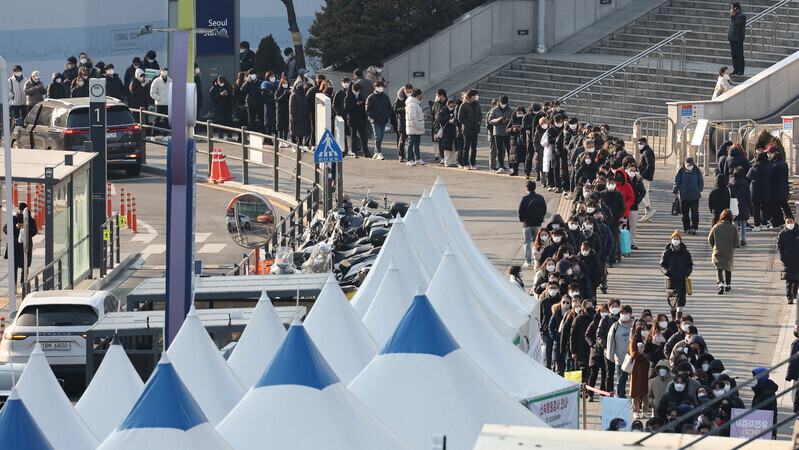hankyoreh
Links to other country sites 다른 나라 사이트 링크
KDCA: COVID-19 cases in S. Korea to peak at up to 270,000 per day by mid-March

Local health authorities are predicting that South Korea will see new Omicron infections peak by the end of February to mid-March. While they forecast that daily case numbers could reach 270,000, disease control authorities are also suggesting that a return to normal routines will be possible once the wave of new infections subsides.
Jeong Eun-kyeong, the commissioner of the Korea Disease Control and Prevention Agency, said in a regular briefing Monday that the Omicron wave will peak near the end of February to mid-March, and the scale of infections will fall between 140,000 and 270,000 new cases per day.
These numbers were produced by combining prediction models from 10 institutions and researchers — eight domestic and two overseas — from Feb. 7-16. The research teams predicted that there would be more than 170,000 new confirmed cases per day next week, and that the number of severe and critical cases would exceed 1,000.
As of the end of the day Monday there were 99,332 new confirmed cases of COVID-19 and 413 severe cases. Authorities are predicting that next week Korea will see a 1.8-fold increase in new cases and critical cases will increase by a factor of 2.1.
Although this estimate greatly exceeds the government's initial announcement of 130,000 to 170,000 new daily cases, disease control authorities say that the public shouldn’t panic over the number of new confirmed cases.
Their explanation for this is that the case fatality rate of COVID-19 has significantly decreased due to the nature of the Omicron variant paired with the effects of booster vaccination rates.
Son Young-rae, head of social strategy at the Central Disaster Management Headquarters, said that the fatality rate for those in their 50s or younger is 0% — 0%-0.03% for those under the age of 59 and 0.17%-4.90% over the age of 60 — making it less lethal for fully vaccinated individuals than the seasonal flu.
“Going through large-scale spread is necessary for transitioning to [COVID-19 becoming] endemic, and the fact that this is happening with Omicron and not Delta is advantageous for Korea,” Son noted.
Hinting at the possibility that social distancing policies may be further relaxed, President Moon Jae-in said at a meeting of senior presidential aides Monday, “From now on, we will flexibly adjust the social distancing measures at any time according to the [overall] change of the situation, focusing on the management of severe cases and the medical system’s response capacity.”
Meanwhile, the Ministry of Education announced adjustments to guidelines to enable 100% distance learning at the discretion of school principals in March, taking into account the local infection circumstances.
By Lim Jae-hee, Jang Hyeon-eun and Lee Yu-jin, staff reporters
Please direct questions or comments to [english@hani.co.kr]

Editorial・opinion
![[Guest essay] Preventing Korean Peninsula from becoming front line of new cold war [Guest essay] Preventing Korean Peninsula from becoming front line of new cold war](https://flexible.img.hani.co.kr/flexible/normal/500/300/imgdb/original/2024/0507/7217150679227807.jpg) [Guest essay] Preventing Korean Peninsula from becoming front line of new cold war
[Guest essay] Preventing Korean Peninsula from becoming front line of new cold war![[Column] The state is back — but is it in business? [Column] The state is back — but is it in business?](https://flexible.img.hani.co.kr/flexible/normal/500/300/imgdb/original/2024/0506/8217149564092725.jpg) [Column] The state is back — but is it in business?
[Column] The state is back — but is it in business?- [Column] Life on our Trisolaris
- [Editorial] Penalties for airing allegations against Korea’s first lady endanger free press
- [Editorial] Yoon must halt procurement of SM-3 interceptor missiles
- [Guest essay] Maybe Korea’s rapid population decline is an opportunity, not a crisis
- [Column] Can Yoon steer diplomacy with Russia, China back on track?
- [Column] Season 2 of special prosecutor probe may be coming to Korea soon
- [Column] Park Geun-hye déjà vu in Yoon Suk-yeol
- [Editorial] New weight of N. Korea’s nuclear threats makes dialogue all the more urgent
Most viewed articles
- 1Yoon’s broken-compass diplomacy is steering Korea into serving US, Japanese interests
- 2[Guest essay] Preventing Korean Peninsula from becoming front line of new cold war
- 3[Column] Why Korea’s hard right is fated to lose
- 4S. Korean first lady likely to face questioning by prosecutors over Dior handbag scandal
- 5Lee Jung-jae of “Squid Game” named on A100 list of most influential Asian Pacific leaders
- 6After 2 years in office, Yoon’s promises of fairness, common sense ring hollow
- 7[Guest essay] Maybe Korea’s rapid population decline is an opportunity, not a crisis
- 8[Column] The state is back — but is it in business?
- 960% of young Koreans see no need to have kids after marriage
- 10[Editorial] Penalties for airing allegations against Korea’s first lady endanger free press